Place (Distribution) Tactics
Introduction
In this chapter, we will explore the theory that underpins the place component of the marketing mix (or Four Ps), which we introduced in Chapter 1 and why this is important for marketers to understand. The chapter will provide an overview of the four major distribution channels used by manufacturers to get their product into the hands of the consumer, focusing in particular on the consumer goods (food and grocery) retail channel. The chapter provides important introductory retail channel and format definitions (terminology) which every consumer goods retail marketer needs to know when making decisions about what products to sell in which retail stores.
The chapter also looks at how the product travels to market, providing a basic overview of the consumer goods supply chain in South Africa, with a view of some of the key developments and trends to watch.
What are place (distribution) tactics and why are they important?
The term Place refers to the distribution and physical availability of the product, in other words, where a product is sold and how it gets there. The goal is to make the product available where consumers will buy it in the quantities and pack sizes they need. For example, a chocolate manufacturer such as Nestlé sells its products at a wide range of outlets, including supermarkets, cinemas, garage convenience stores, vending machines, wholesalers and online.
The different avenues available for a manufacturer to make their product available to consumers to buy are known as distribution (or marketing) channels.
A distribution channel is made up of interdependent organisations, (referred to as intermediaries or marketing intermediaries), that help to make a product (or service) available for use or consumption by the consumer or business user.1
Figure 15.1 shows the four principle distribution channels available to consumer goods manufacturers. The direct channel, the retail channel, the wholesale/distributor channel and the agent/broker channel.
Choosing the right distribution channel or combination of channels for a product will affect the success or failure of that product. Most large consumer goods manufacturers will choose a combination of distribution channels to get the best sales results for their products. This is known as a multi-channel strategy.

The marketer needs to weigh up a number of factors to make sure their product gets to their target consumer in the most efficient, cost-effective way and which is also in line with the brand's objectives Whichever the route (or routes) adopted, the relationship between the manufacturer and its channel partners, whether retailers, wholesalers, distributors, logistics businesses or agents, and how well they work together to meet the consumer's needs, will directly impact a product's success.
Why manufacturers use distribution channels
Why do manufacturers (producers) choose to work with channel partners when it would appear to be more complicated than simply selling directly to their target consumer? The selling direct route might make sense when you are selling a service such as a haircut, but what if, when you were doing your grocery shop, you had to contact and buy the products from all the different manufacturers who make the products in your shopping basket? It would be a very inefficient way to shop.
Figure 15.2 illustrates this principle. The first part of the diagram shows the direct-to-consumer route, with each manufacturer selling individual products to each individual consumer. Here, each manufacturer must sell and deliver to five consumers and those consumers needing to buy a range of household and personal care products, such as a bottle of shampoo, a can of deodorant and a tube of toothpaste would need to buy from three different manufacturers to get the range of products they need. With the introduction of a retailer as a channel partner, as shown in the second part of the diagram, the manufacturer needs to sell a box of deodorants to only one retailer to reach five consumers and those five consumers can buy the range of products they need from one retailer. So instead of Unilever selling individual boxes of Skip or Omo to consumers, it sells many boxes to a supermarket nearby, which sells Omo to many consumers.
Companies partner with intermediaries not because they necessarily want to (ideally, they could sell their products straight to users) but because the intermediaries can help them sell the products better than they could working alone.[2]
- It allows for specialisation and division of labour which in turn should allow for improved efficiencies and lower average production costs. It means manufacturers can focus on the job of manufacturing and retailers the job of retailing. This principle however is shifting with the increasing disintermediation in the market. We will look at this later in the chapter.
- It enables consumers to buy single units of wide range of products in one place instead of having to deal directly with many manufacturers.

Route-to-market and choosing the right distribution channels
A traditional, linear view of a product's route-to-market from the product source to the consumer is shown by the blue arrows in Figure 15.3.
This end-to-end supply chain includes primary-sector businesses (raw materials),for example, farmers, mining companies and forestry, secondary-sector businesses, predominantly manufacturers and tertiary-sector businesses, (services sector) for example, banks, wholesalers, retailers, distributors, and transport companies, known as third-party logistics or 3PL. As the world shifts to a circular economy construct (Chapter 3), waste management businesses and 'reverse logistics' play an increasingly important role in the supply chain, illustrated by the green arrows in Figure 15.3.
Integrated Waste Management (IWM) is a comprehensive waste minimisation, handling and disposal approach. An effective IWM system considers how to avoid producing waste in the first place, how to re-use and recycle waste materials and how to store, collect, transport, treat and dispose of the waste in the most efficient ways possible, to protect human health and the environment.[4]
In the case of consumer marketers, the focus is usually on the downstream distribution channels which we look at in the next section rather than the upstream supply chain, which we will look at in more detail later in the chapter.

A product's route to market, however, is very seldom as linear as the diagram in Figure 15.3 and distinctions between the channels are not as clear-cut as we may like them to be. Figure 15.4 shows how businesses sell across the channels. For example, a product can be sold by a retailer to another retailer as opposed to directly to the consumer; or a wholesaler will sell to a distributor who then sells to an informal retailer who sells to the consumer. Wholesalers may sell to consumers as well as to independent retailers. This trend is referred to as channel blurring (Chapter 6).

Consumer marketers need to know the distribution channels available to them in order to:
- Prioritise the best channels to connect with target consumers.
- Focus resources and time on the channels with the biggest potential for profit and growth.
- Manage resources in channels with limited future growth.
- Maintain business in channels where products are performing well.
The marketing environment is always changing, so understanding and tracking channel trends is important for marketers - what was a great channel or channel partner yesterday might not be a great channel partner today or in the future. Changes in technology, production techniques, and the customers' needs mean manufacturers must continually re-evaluate marketing channels and the channel partners with which they ally.
The decision regarding which distribution channels to use will depend on the answers to some key questions, including:
- What is the total value of the channel in the category in which the manufacturer trades (measured in rand sales)?
- How profitable is the channel to the manufacturer and what is the 'cost-to-serve'? (a profitability calculation based on the actual business activities and overhead costs incurred).
- Supply chain and distribution costs
- Trading terms, which include costs such as new product listing fees, promotional fees, and distribution centre costs.
- Is the channel growing or declining overall, and in the manufacturer's categories?
- What is the future expected growth from the channel and the targeted categories?
Defining consumer goods distribution channels
The following section takes a more in-depth look at some of the primary consumer goods product distribution channels in South Africa.
Direct to consumer (D2C) channel
The direct channel is one in which the manufacturer chooses to sell directly to the consumer. It is also referred to as the direct-to-consumer (D2C) channel or non-store retailing channel. Manufacturers use different methods (platforms) for direct sales such as selling products online or via home party selling, like Tupperware, Avon and Herbalife, catalogue selling, vending machines and telesales.
There are a number of advantages and disadvantages for marketers in using a D2C channel. Advantages include being quicker to market when launching a new product and having control over brand image, pricing and profitability. Advantages also include direct access to consumer data such as demographics, shopping habits, interests and preferences for better selling and servicing of customers. D2C also facilitates a direct relationship with the target consumer. Disadvantages of D2C channels include the high cost of multiple distribution (delivery) points and (mostly) limited assortment of products available for sale (so not a convenient grocery shopping solution). In addition, D2C lacks the personal interaction present at bricks-and-mortar retailers and the consumer is unable to experience the product before buying it. Whether the advantages outweigh the disadvantages varies significantly between different kinds of products, whether it is high priced article of clothing or a can of deodorant.
Retail channel
The retail channel involves the introduction of the retailer as an intermediary between the manufacturer and its targeted consumer. Retailers purchase products directly from manufacturers or from wholesalers and sell directly to end consumers. In Chapter 6, we explored retail in South Africa in some detail.
In the consumer goods sector, there are different kinds of retail channels (we explored two key retail channels in Chapter 6, formal and informal retail). Each retail channel is made up of different retail formats.
A format is a group of similar retail businesses, with similar attributes, which target a similar shopper profile and fulfil a similar shopping mission.
For example, Pick n Pay Express and Woolworths Foodstop are convenience format stores. They have the same attributes; a small trading area with a limited range of products catering for shoppers doing a pop-in or top-up shop. On the other hand, a Pick n Pay Hypermarket and a Checkers Hyper are large format stores with a big trading area and much wider range of products, usually catering for shoppers large monthly shopping needs.
Marketers need to ensure that the right product variants and pack sizes are listed (stocked) not only in the right retail channels, but also in the right retail formats, at the right price to appeal to the consumer who shops at that store format. Later in the chapter, we look at formal definitions of the consumer goods retail formats in the South African market.
There are advantages and disadvantages of the retail channel to the consumer marketer. Advantages include aspects like location and shopper access. Bricks-and-mortar retailers are situated in locations that are convenient for shoppers, whether in their neighbourhood or in the local or regional shopping centre or in outlying rural areas. Retailers operating online offer shoppers the convenience of grocery basket or trolley deliveries to home or work. Other advantages include access to a wide product range and assortment available in a single location. Retailers will buy large quantities of product (packed in bulk) from a range of manufacturers, giving the manufacturer the economies of scale they need. The retailer will break the bulk packs (known as cases or shrinks) into single units or smaller multi-packs at their distribution centre or at the store to suit the shopper's needs.
Some disadvantages to the brand marketer include limited control over product selling price, positioning and visibility in-store. In addition, there is no direct access to consumer shopping data and no direct interface with their target consumer. These advantages and disadvantages need to be weighed up by marketers and will differ depending on the product and product category.
Some disadvantages to the brand marketer include limited control over product selling price, positioning and visibility in-store. In addition, there is no direct access to consumer shopping data and no direct interface with their target consumer. These advantages and disadvantages need to be weighed up by marketers and will differ depending on the product and product category.
Wholesale/distributor channel
The wholesale channel is also referred to as the distributor channel, not only because it includes distributor-focused businesses, but also because wholesalers play a key role in distributing manufacturers' products to market. The line between wholesalers and distributors has become increasingly blurred.
Wholesaler
A wholesaler is primarily engaged in buying and usually storing as well as physically handling goods in very large quantities, which are then resold (in smaller quantities) to retailers or to industrial or business users.
For a business to classify as a wholesaler, at least 70% of sales must be to commercial customers buying goods for resale.
In the South African consumer goods marketplace, wholesale cash-and-carry and distributor businesses play a significant role in the distribution of products to the formal and informal independent retailers across the country. In Chapter 6, we looked at the major buying groups that make up a large part of the formal independent retail sector. The majority of these buying groups also operate in the wholesale/distributor channel. They began as organisations with predominantly wholesale cash-and-carry members, but, as a result of the channel blurring trends we looked at in Chapter 6, many of the members of these buying groups shifted their businesses from predominantly wholesale trading, selling to commercial customers, to retail or retail hybrid trading, selling to both business customers (products in shrinks or cases) as well as household or individual customers (single units of product). Examples of some of the big South African wholesale players are Continental C&C, Favours C&C (part of the Independent Buying Consortium, IBC) and Cosmo Cash & Carry. A business that has stores which fall into both the retail hybrid classification and wholesale cash-and-carry classification is Makro, part of Massmart Walmart.
Distributor
A distributor is an entity that buys noncompeting products or product lines, warehouses them, and resells them to retailers or direct to the end users or customers. [7]
A local example is Bacher and Co, a distributor which offers manufacturers a range of services that extend up and down the value chain. Bacher and Co will hold manufacturer's stock at a warehouse and handle distribution to retailers' warehouses, as well as handle direct-to-store deliveries, using advanced technology to facilitate the ordering and delivery processes.
Bacher and Co employs a countrywide network of merchandisers and sales managers who call on all major retailers, pharmacies, and fashion and jewellery chains (such as Foschini, Woolworths, Busby, Dis-Chem and Clicks), as well as a large number of independent retailers.
Just as wholesalers have been shifting increasingly into retail to chase higher margins, distributors have been shifting into wholesaling as a means of capturing more business from the value chain. An organisation such as The Diplomat Group, a sales and distribution company in the FMCG sector and agent for P&G in South Africa, has expanded its distribution capabilities to include distributing to small, informal independent retailers on behalf of a number of manufacturers. This puts the distributor and the wholesaler in competition for the same commercial shopper.
Tradeport, a member of the Independent Buying Consortium (IBC), is an example of a business which operates both as a wholesaler selling goods to commercial customers and a distributor with a fleet of trucks, some of which are owned and some of which are independent, which are used to distribute goods to thousands of independent retail stores.
Agent/broker channel
The Agent/Broker channel involves the product passing through a number of intermediaries (middlemen) before it reaches the consumer. Agents and brokers are different from wholesalers in that they do not take title to the product. In other words, they do not own the product because they neither buy nor sell. Instead, brokers bring buyers and sellers together and negotiate the terms of the transaction. Agents represent either the buyer or seller. For example, a manufacturer can engage an agent to obtain new wholesale customers or a wholesaler can engage an agent to look for new retail business accounts. Another example, in a different field, is a residential estate agent. The agent does not buy the home and then sell it to someone else; they market and arrange the sale of a home and take a commission on the cost of the sale.
Disintermediation
The process of cutting intermediary businesses, or middlemen, out of the chain is a process marketing professionals call disintermediation [6]. The channel blurring trend we discussed in Chapter 6 is a result of disintermediation. Grocery retailers, such as Shoprite, with its Ritebrand private label, or Massmart Walmart, with First Choice private labels, are bypassing branded manufacturers and setting up their own product sourcing and branding departments supplying their retail stores. The subject of private label is covered in more depth in Chapter 12. Manufacturers who make the decision to sell their products directly to informal independent retailers, using their own distribution centres and 'last mile' transport solutions, are disintermediating wholesalers. Cutting out the intermediary business is sometimes desirable but certainly not always.
Understanding consumer goods retail channel terms and definitions
Marketers need to ensure that the right product variants and pack sizes are available for shoppers to buy in the right retail formats, at the right price to appeal to the consumer who shops at that retail format. Targeting the right retailers with the right products requires a sound understanding of retail channel and retail format characteristics and attributes.
South African retail channel and format definitions were developed by Trade Intelligence (Ti) in partnership with Nestle South Africa in 2017 and validated against valuable work done by global and local consumer goods manufacturer's such as Unilever, Tiger Brands and Kellogg's on the subject.
These definitions have been adjusted for application to the 2020 retail landscape. The differentiating characteristics and attributes have been chosen to provide an introductory understanding for marketer's. There are many others which manufacturers will consider when grouping retailers, such as ownership (Chapter 6) or operating methods (which helps with understanding your cost to serve), Here we define the retail formats according to:
- Shopping mission. Shoppers use different stores for different reasons. The shopping mission is the primary reason or purpose of a shopping trip from the shopper's perspective. Shoppers visit different retail outlets (formats) for different reasons and marketer's need to understand the shopping mission to make sure the right product and pack size are available to satisfy the shoppers need on that shopping mission. Some examples of shopping missions are shown in Figure 15.5.
- Shopper profile. It is important to know the demographics of the shoppers who shop at a particular retail format or store. For example, a low-income shopper will often shop at a different store to a high-income shopper.
- Product range. How many SKU's does the store carry? Does the store carry a narrow or wide range of products?; SKU is an acronym for stock keeping unit. This is a unique code consisting of letters and numbers that is created by retailers to identify each product the store carries. [8] Product characteristics such as manufacturer, brand, variant and pack size are reflected in the SKU number and are used by retailers to identify and track their sales, inventory, or stock levels. An SKU is an internal code created by the retailer and is not the same as the UPC bar code on a product, which is the same no matter who sells the product.
- Price positioning. Is it a discount store or a premium-priced store?
- Store location. Is it in an urban or rural area, is it a standalone shop or in a shopping centre?

Table 15.1 is a snapshot of the consumer goods retail channels and retail formats in South Africa. It is important to note this does not include the speciality retail or pharmacy channels which are important for marketer's working in the health and beauty (personal care) categories for example, so it is important to make sure you know the full breadth of retail channels relevant to the product categories you work in.
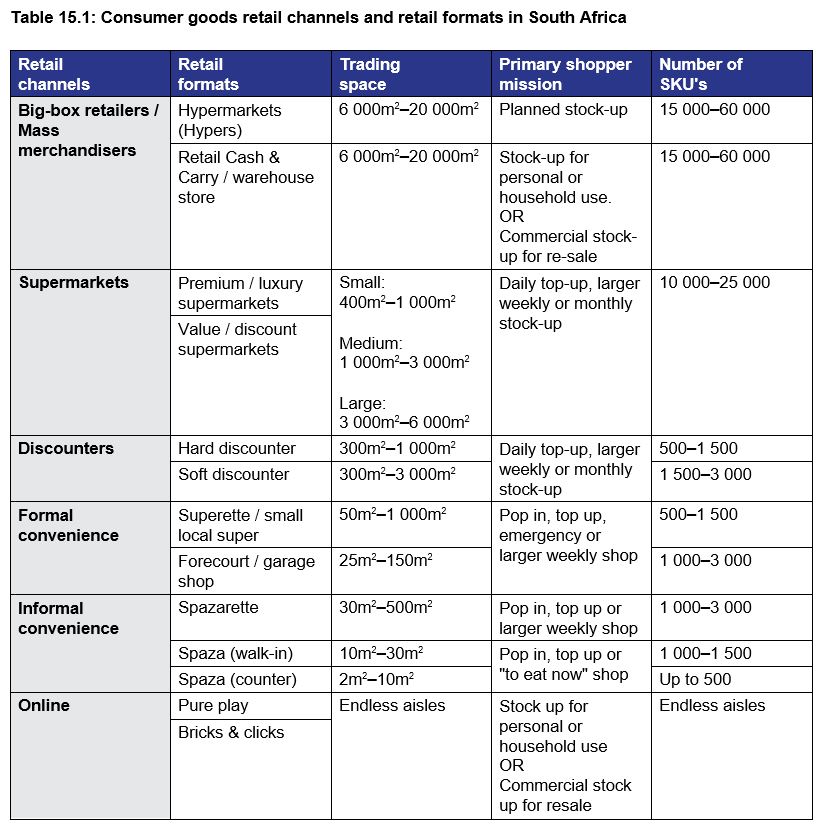
Omnichannelis a term that is increasingly prevalent as online (e-retail) grows and shopper's interact with the products they are looking to buy across a range of platforms such as Facebook, Instagram or customised apps. It refers to a way of selling products that is the same and equally good for the customer whether they are buying from a physical shop, a computer, a mobile phone app, etc. In an omnichannel environment, channels are used seamlessly and interchangeably during the shopper's search and purchase process. [9] For the sake of the terms and definitions below online (e-retail), is treated as a retail channel although there is some debate whether online retail is a retail channel of its own or if online is simply another kind of retail format.
In the following subsections, South Africa's main retail channels are defined at a channel and format level using selected characteristics and attributes.
Big-box retailers and mass-merchandisers
These are large destination stores, which sell a very wide range of product categories, in bulk (whether single units or shrinks), at competitive prices. They cover a floor space of 6 000 to 20 000 m2, and stock anywhere between 15 000 and 60 000 SKUs (stock keeping units).
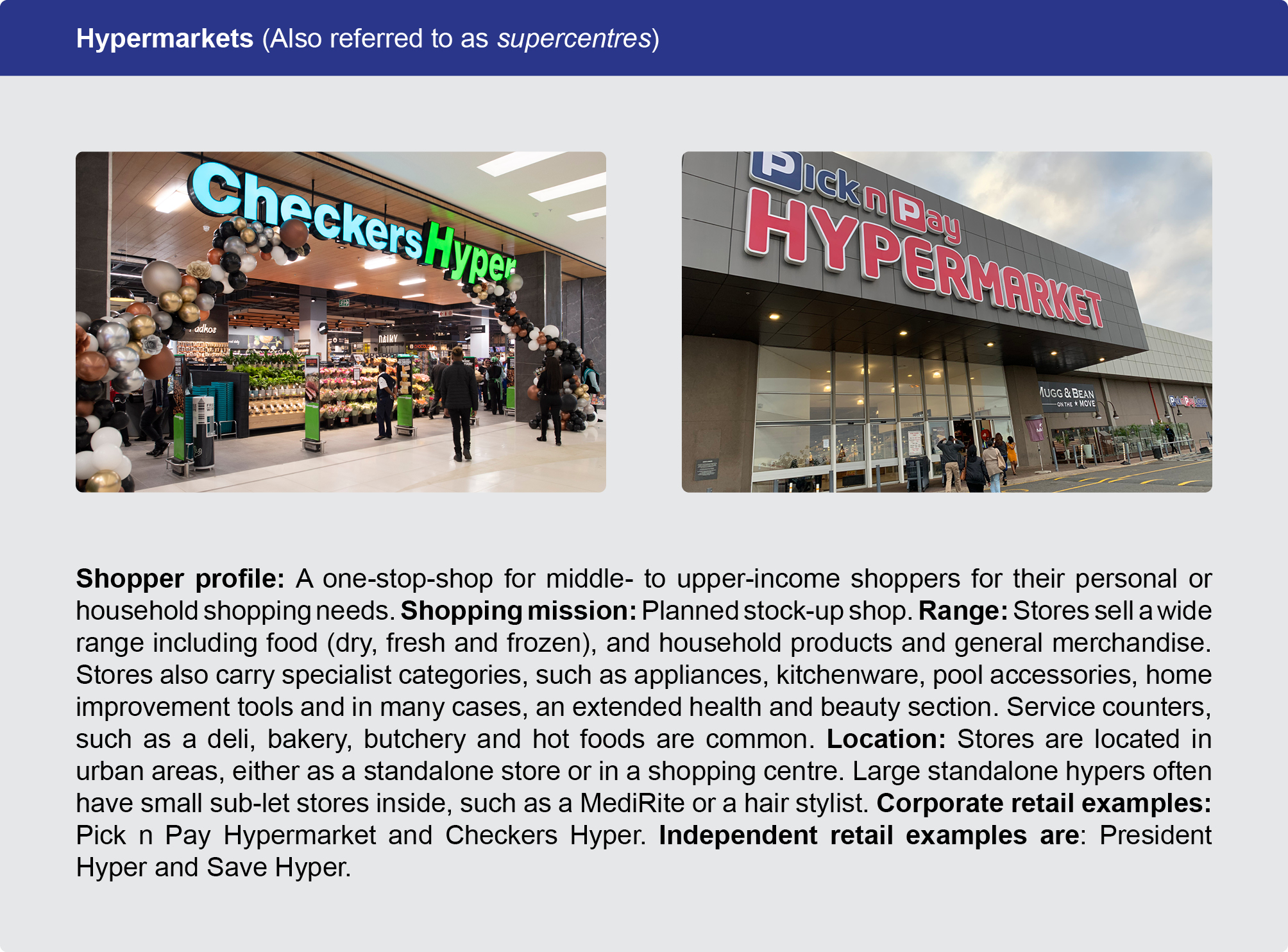
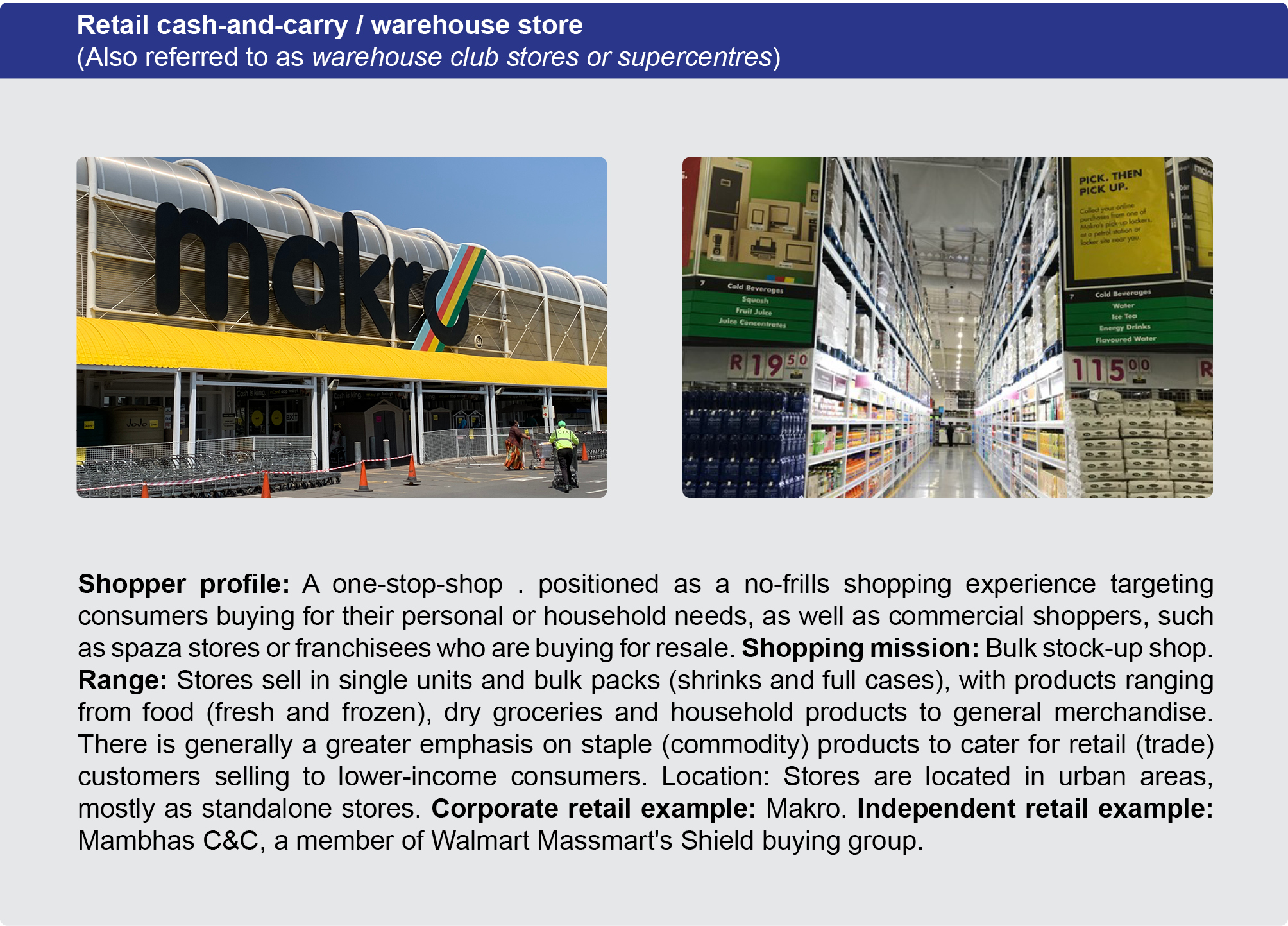
Supermarkets
Size & Range: These are grocery self-service stores, which sell a range of food (fresh and frozen), household with some general merchandise products to shoppers for individual and household use. The range is often complemented by service counters, such as butchery, bakery, deli and hot food. Shopping mission: Daily top-up, larger weekly or monthly food and grocerystock-up needs. Size: Stores range from small neighbourhood supermarkets (400 –1 000 m2) to medium (1 000 – 3 000 m2) and large (3 000 – 6 000 m2) stores situated in shopping centres or as a standalone outlets, stocking anywhere between 10 000 and 25 000 SKUs. Shopper profile: Supermarket shoppers fall across the income spectrum, with stores which serve low-income shoppers carrying more basic necessities (commodity) lines than stores serving middle- to upper-income shoppers, which will carry speciality food counters such as sushi or pizza bars.
In the South African context, because of the income disparity between shoppers and the impact of shopper income on the store's product range, these outlets are most often segmented according to shopper income profiles.
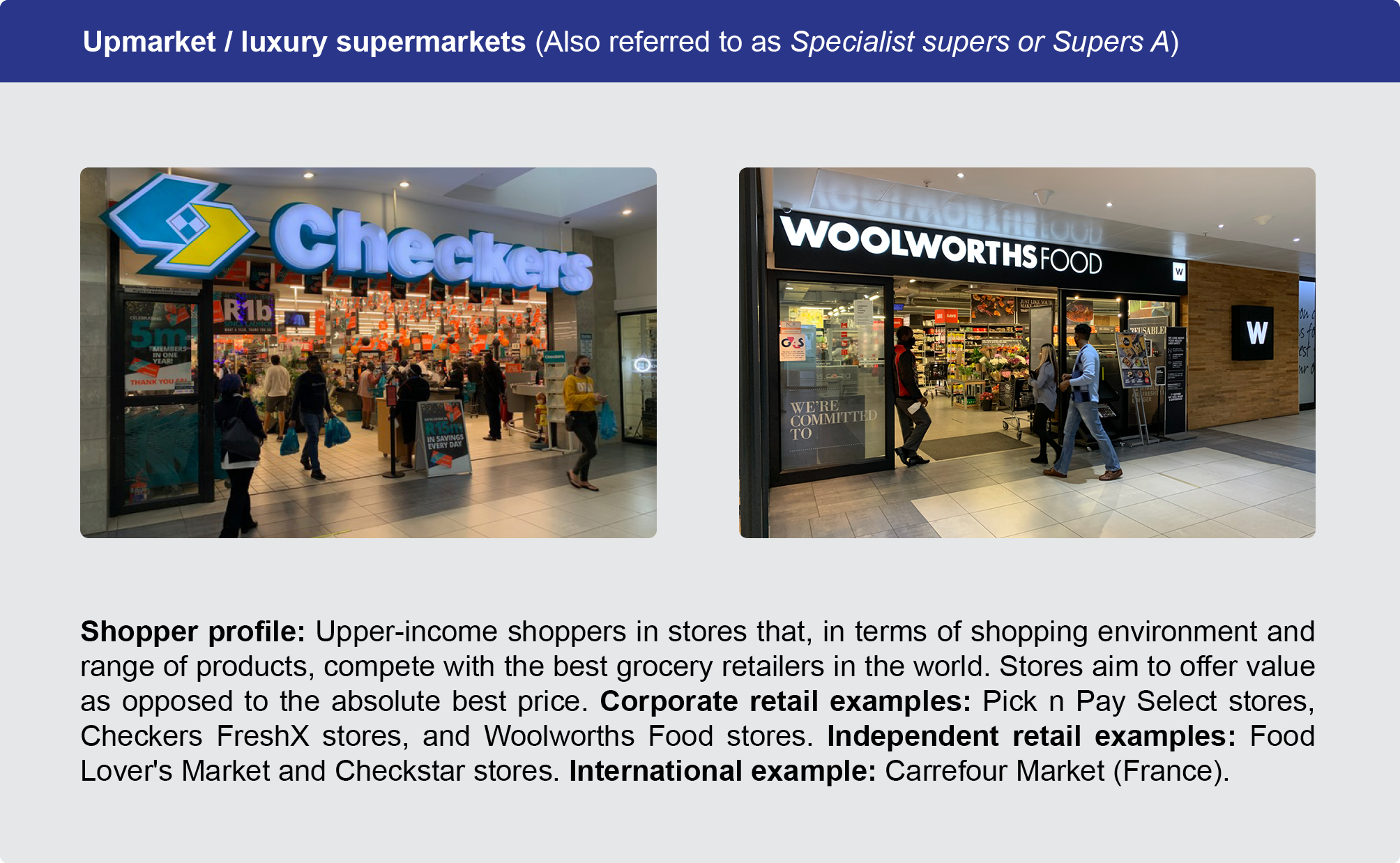

Discounters
The discounter business model was developed in post-war Germany and was focused on selling a limited range of absolute necessities at very low prices in a sparse, no-frills store environment. The model is based on leveraging buying power with suppliers, selling a high proportion of private label lines and keeping logistics simpler and cheaper than a supermarket. The model has evolved over the years and in South Africa certain retailers have drawn on aspects of the model and depending on the extent of the application, they are classified as hard or soft discounters. Discounters were originally designed to cater for lower-income consumers but have increasingly captured middle-income consumers looking for a good deal.
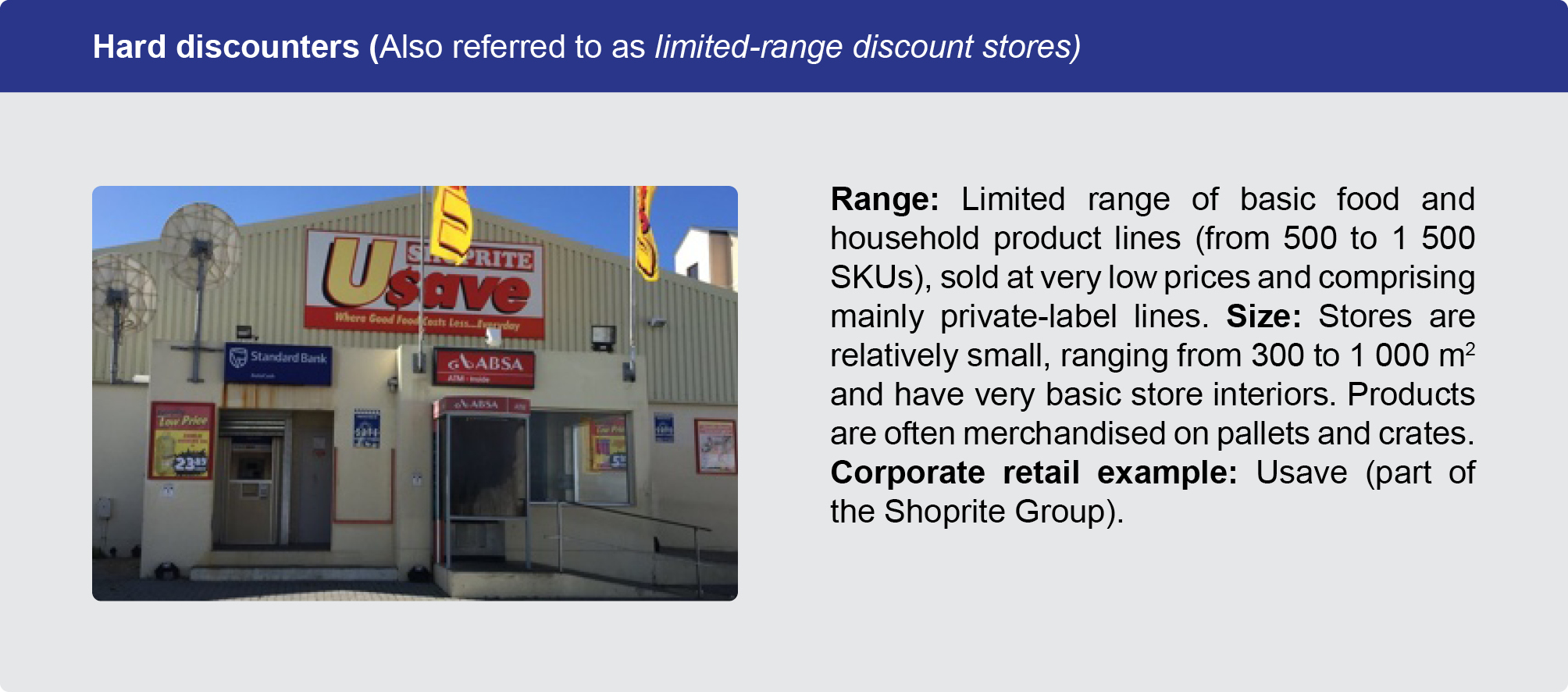
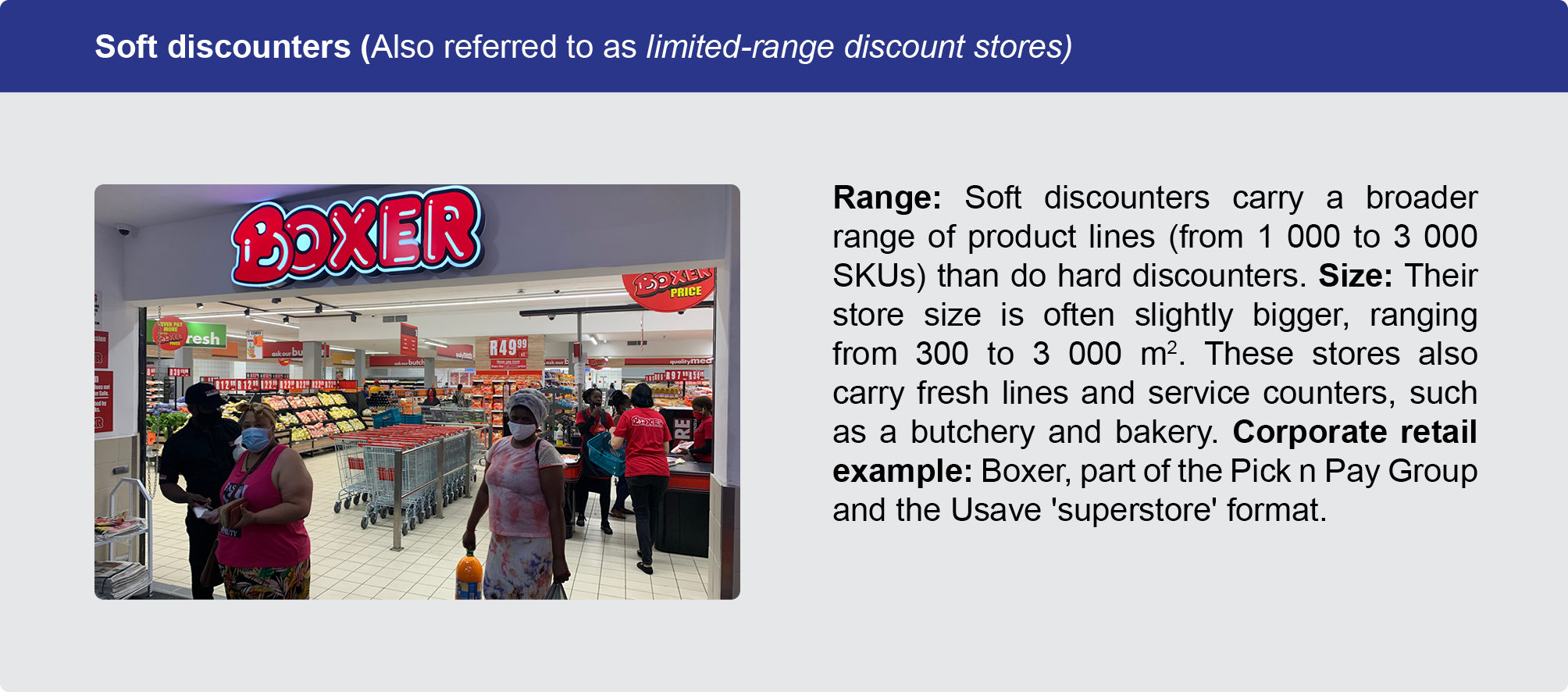
Convenience retail (formal)
Location: By their nature, a convenience store must be conveniently located for the consumer (or must have the ability to deliver the product to the consumer as conveniently as their visiting the local store). Shopper mission: Stores serve shoppers pop-in, daily top-up or emergency shopping needs. Size: Convenience stores can be as small as an informal retail spaza store of 2 m2 to a Woolworths Food neighbourhood store of 1000 m2 and carry a much smaller range than a traditional supermarket. The shopper profile and the location of the store will impact the kinds of product lines the store will carry. For example, a Woolworths Food neighbourhood convenience store in Sandton will stock a different range of products to a peri-urban KwikSpar trading in Mthatha or a spaza in Alexandra.
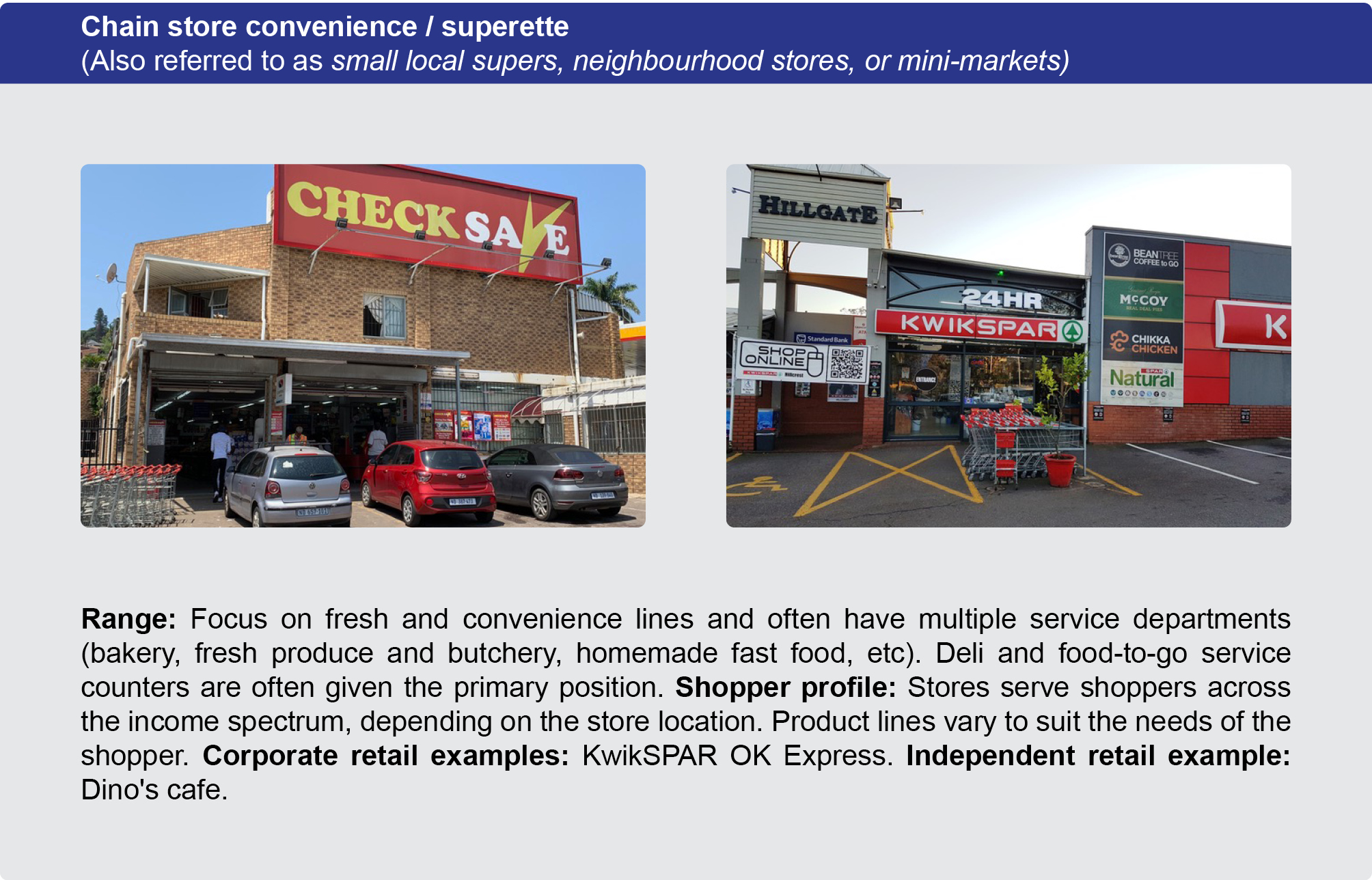

Convenience retail (informal)
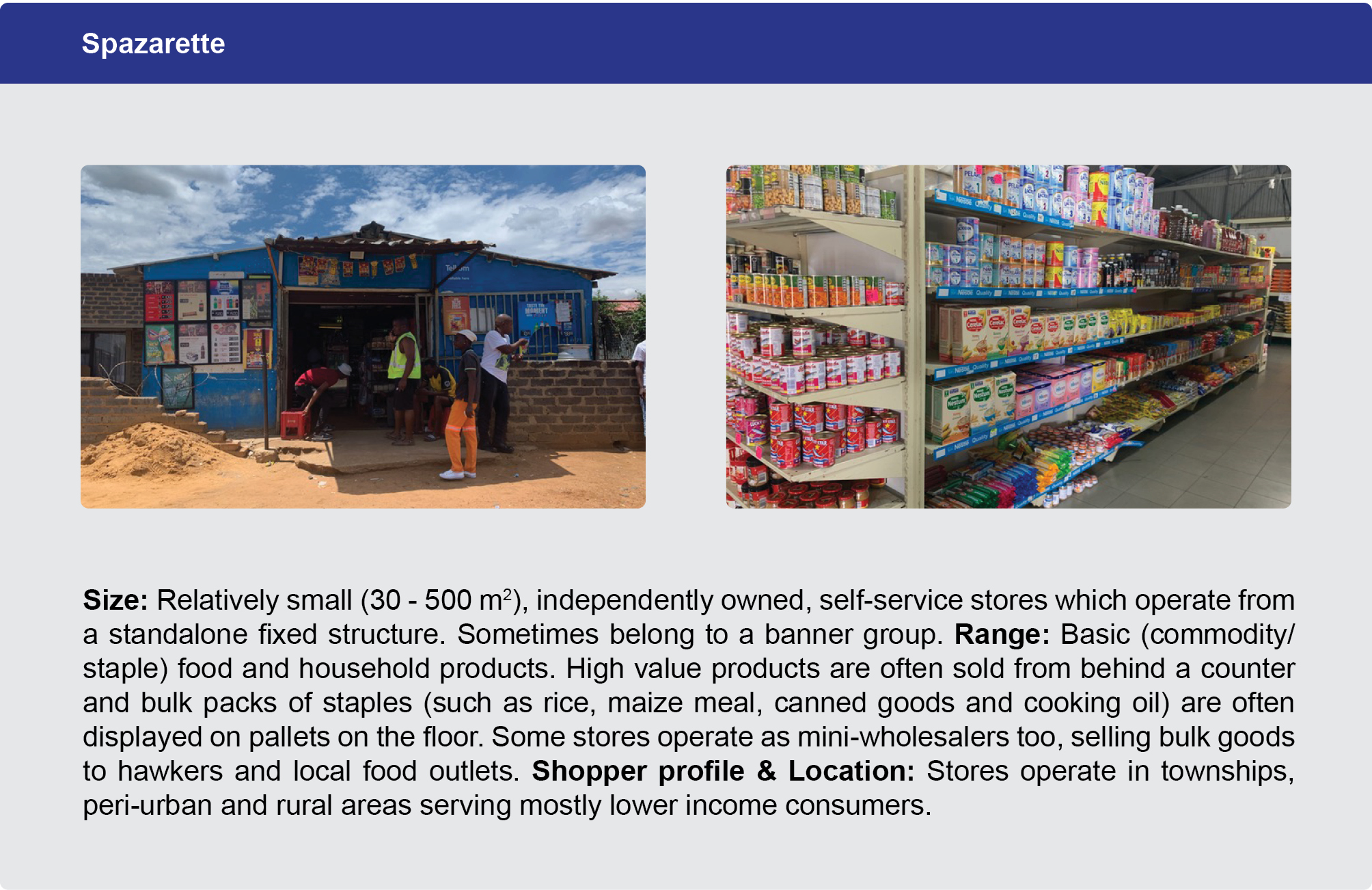
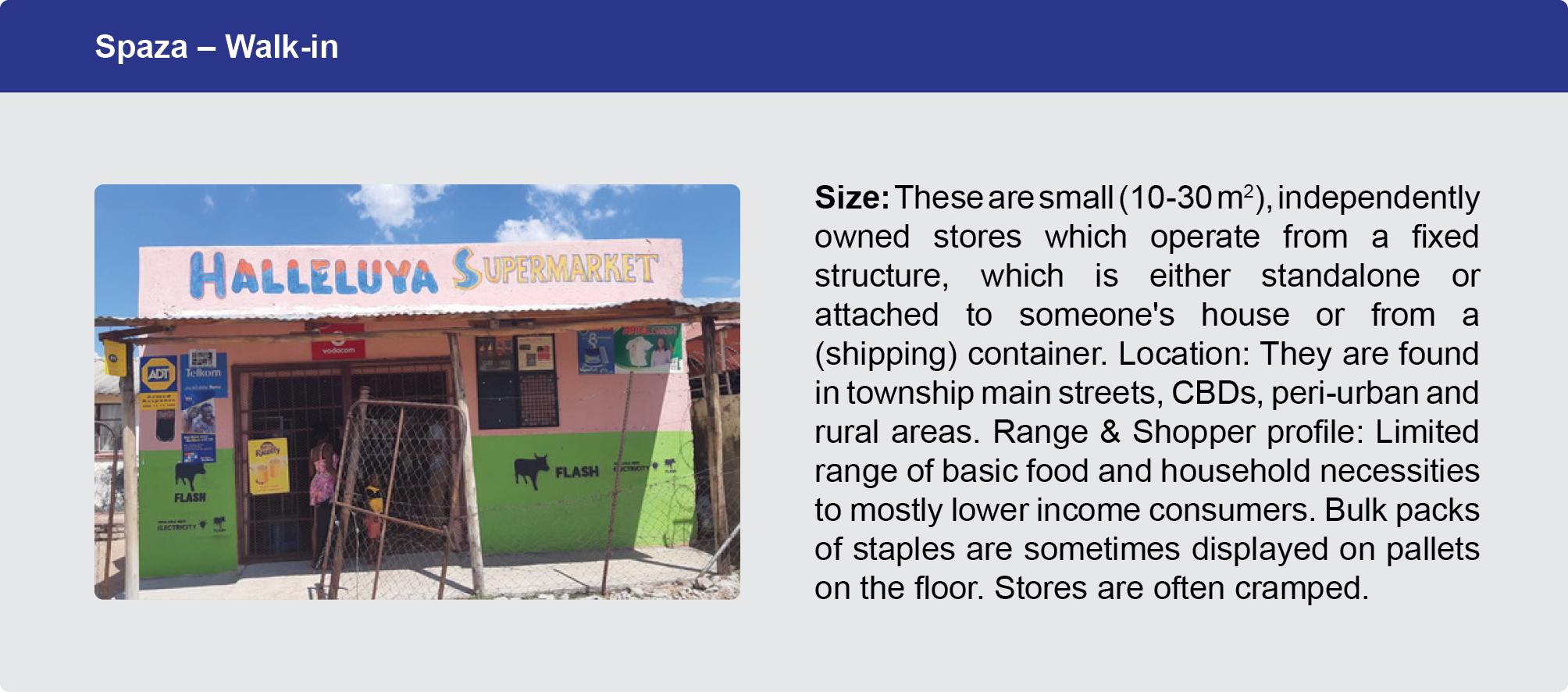
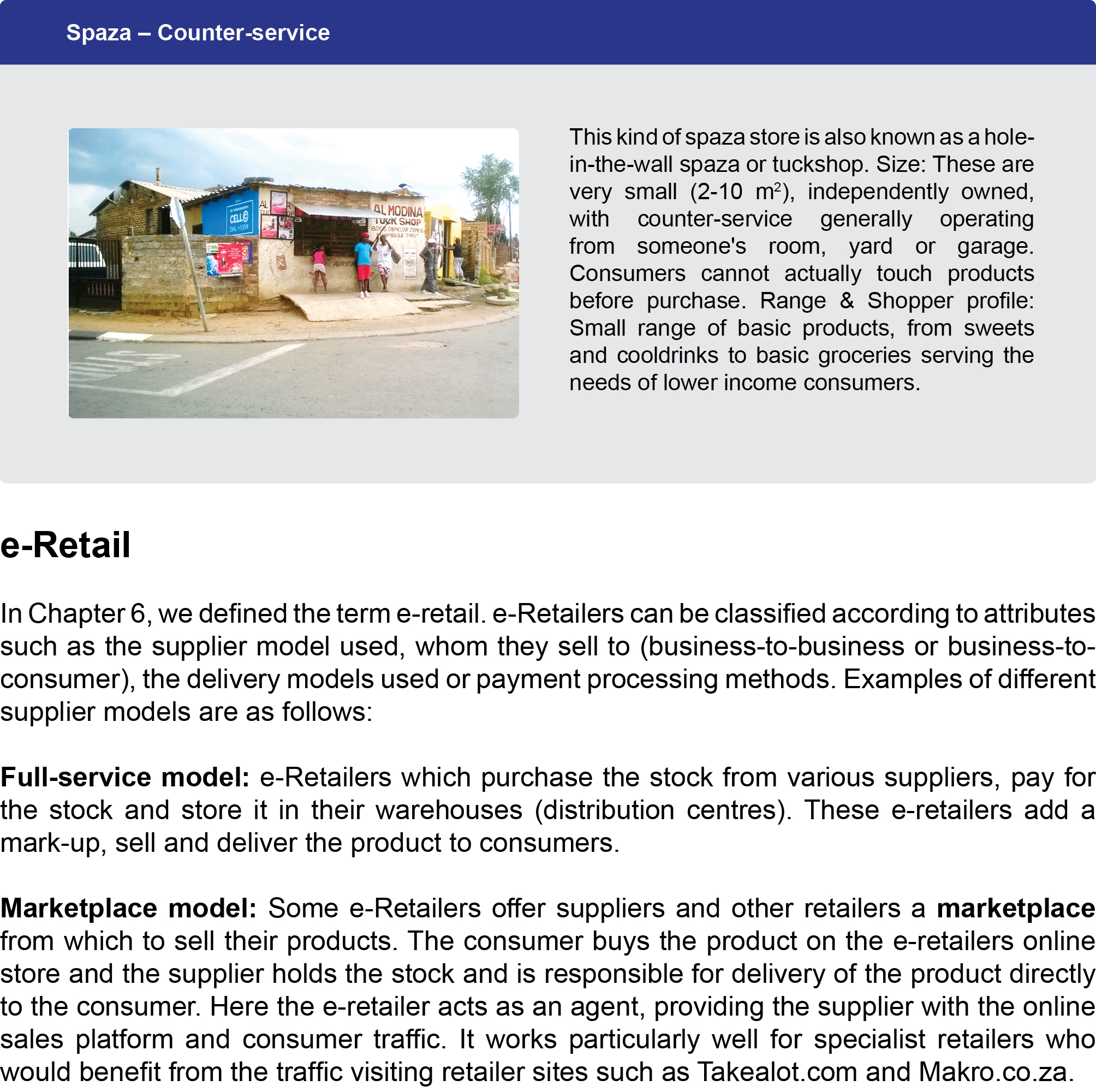
e-Retail
In Chapter 6, we defined the term e-retail. e-Retailers can be classified according to attributes such as the supplier model used, whom they sell to (business-to-business or business-to- consumer), the delivery models used or payment processing methods. Examples of different supplier models are as follows:
- Full-service model: e-Retailers which purchase the stock from various suppliers, pay for the stock and store it in their warehouses (distribution centres). These e-retailers add a mark-up, sell and deliver the product to consumers.
- Marketplace model: Some e-Retailers offer suppliers and other retailers a marketplace from which to sell their products. The consumer buys the product on the e-retailers online store and the supplier holds the stock and is responsible for delivery of the product directly to the consumer. Here the e-retailer acts as an agent, providing the supplier with the online sales platform and consumer traffic. It works particularly well for specialist retailers who would benefit from the traffic visiting retailer sites such as Takealot.com and Makro.co.za.
The two primary e-retail format classifications are pure-play and bricks-and-clicks.
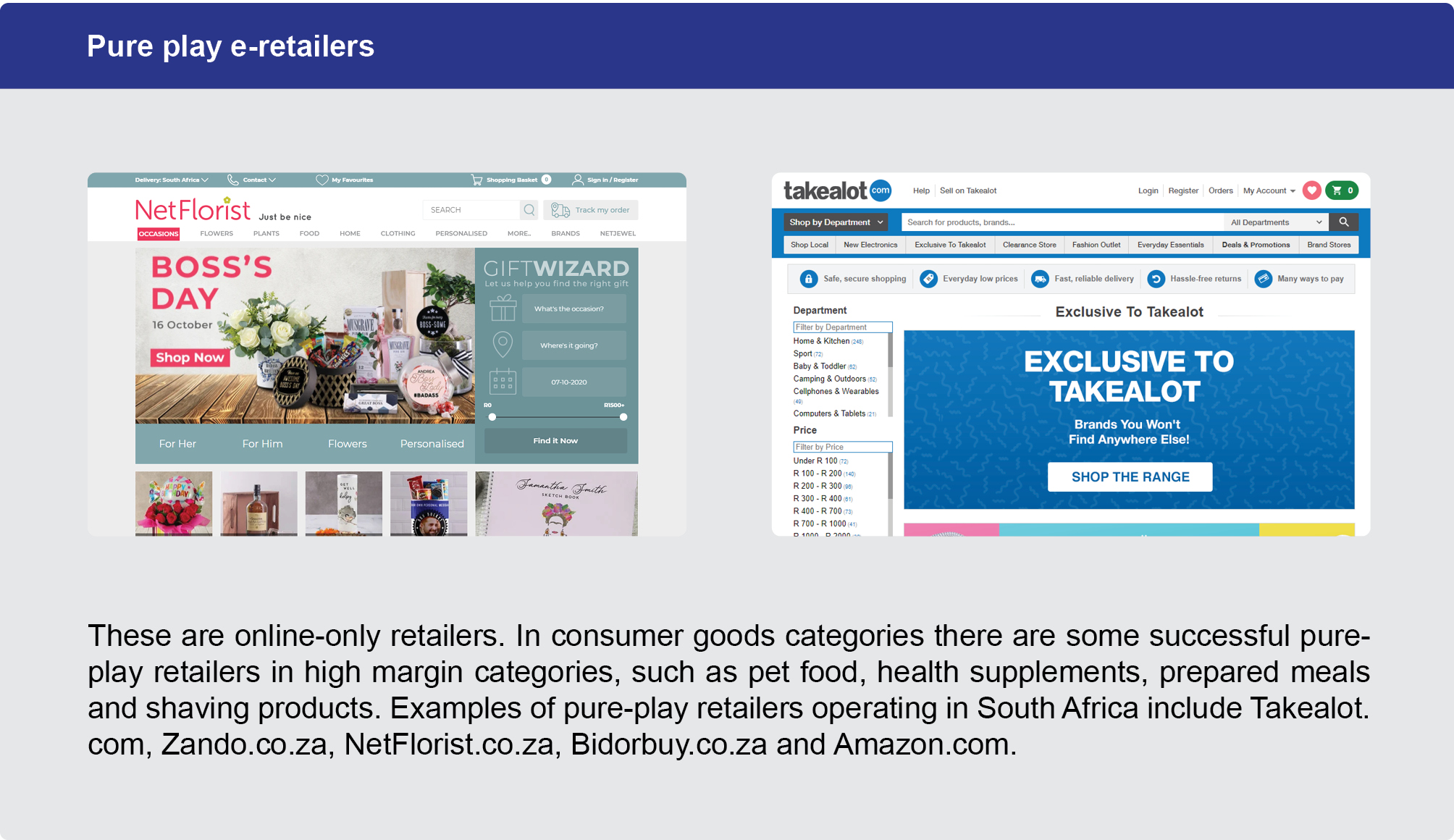
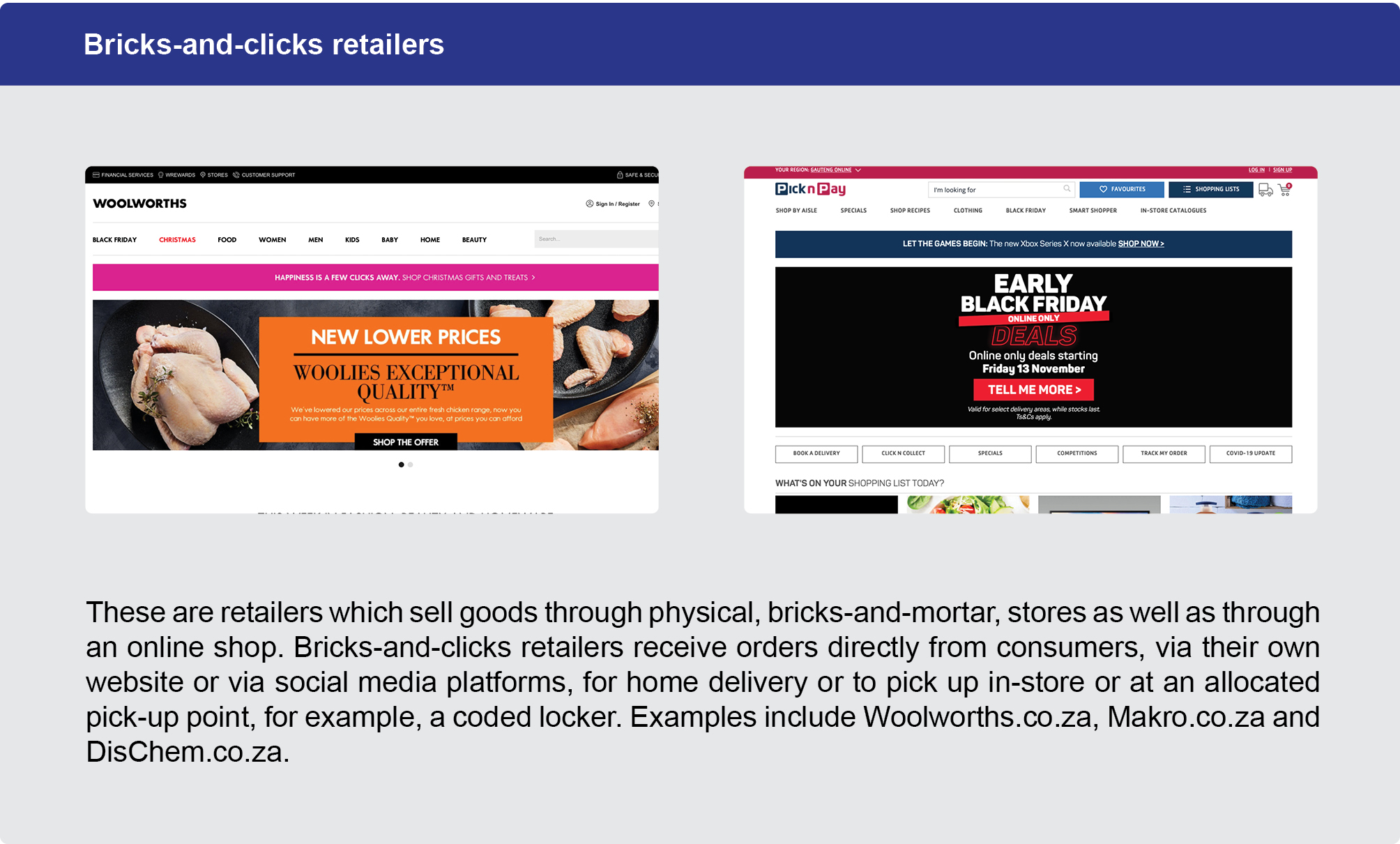
The right in-store location
The final step in the product's journey to the consumer is where it sits inside the retail store. The term point of purchase is used by manufacturers to refer to the place where the product is presented to the consumer for purchase, it can be a shop shelf, a promotional display or on a website. It is at the point of purchase that the 'moment of truth' happens – the customer makes the decision to buy the product.
Although shoppers are all different, they can be influenced to buy certain products at the shop shelf using effective merchandising techniques. Merchandising is a term that is used differently by different organisations, but in the context of a consumer goods manufacturer, the term merchandise means:
products available for sale, typically in a retail setting. Merchandising is everything you do to promote and sell your products once the potential customer is in your store. [11]
Merchandising typically involves presenting products in a visually favourable light, with the intention of encouraging the consumer to buy. Good merchandising is a critical part of successful retailing. As a marketer, some of the most important merchandising considerations are:
- The product's location in the store
- The amount of space that is allocated to the product on the shop shelf
- How well the shelves in the store are stocked
- The point-of-sale material used to highlight or promote the product in the store
Effective merchandising can have a significant impact on the success of a product. It drives higher sales, encourages shoppers to spend more time in the store and makes the shopping decision easier. An important merchandising tool is a planogram, which is shown in Figure 15.6 and is formally defined as 'a schematic drawing or plan for displaying merchandise in a store so as to maximize sales.' [12]
The planogram shows where and how many units of product are displayed on the shop shelf. The intention is to optimise the selling potential from every bit of space in the store and it provides an easy reference guide to product merchandisers who would be packing the products from various suppliers onto the store shelves. The planogram is an important tool as it helps with stock control, making the ordering of stock much easier for the retailer, which will help reduce out-of-stock situations, which lead to lost sales.
It is important for marketer's to focus on the performance of their products across a range of measures at the point of purchase. Some of these measures are listed below and many manufacturers refer to performing well against these as 'winning at the point of purchase (PoP)'.

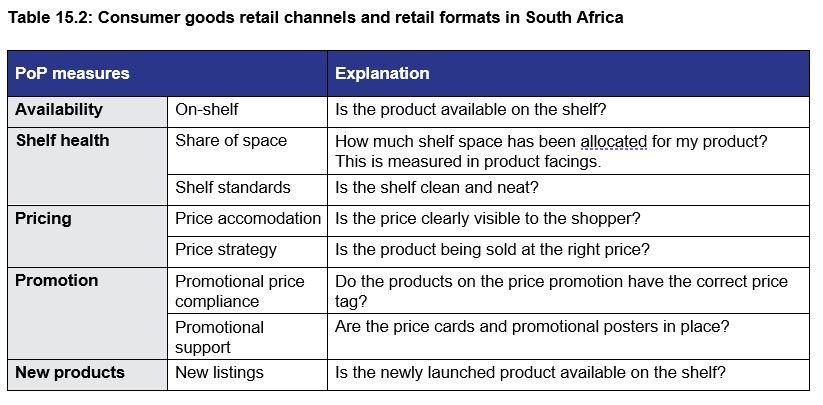
The supply chain (how the product gets to market)
In the first part of this chapter, we looked at where the manufacturer's product is sold and in particular the retail channels and retail formats available to marketers. We now look at how it gets there. This is the end-to-end supply chain (Figure 15.3). and consists of a system of organisations, people, activities, information and resources involved in moving a product or service from the product source to the target consumer.
Supply chain and logistics management in South Africa is a challenge for businesses from the perspective that, as the 26th largest country in the world, the country spans 1.2 million square kilometres, roughly the same area as France, Germany and the United Kingdom combined. For example, if a product is manufactured in Cape Town and requires transporting by road to a retail operation near the Zimbabwean border in the north, it is the equivalent of driving from Paris, France, to the Russian border, almost the complete width of Europe. This has big cost implications. In the consumer goods retail industry in particular, low operating profit margins necessitates sharp focus on logistics cost whilst maintaining acceptable customer service standards.
The importance of the supply chain in manufacturer and retailer competitiveness
Historically, supply chains and distribution centres were viewed as cost centres by many organisations. Today, across each of the distribution channels, the supply chain has become a key competitive factor (and will differentiate between the winners and the losers). The growth in online retail and developments in technology mean that retailers and manufacturers have had to elevate the importance of their supply-chain capabilities to be able to serve the needs of the modern consumer, while efficiently managing the costs required to do so. [14] Manufacturers and retailers have had to look at new ways of getting products into the hands of consumers. This has meant new supply chain and logistics models and there is a delicate balance between service, speed and cost.
A distribution centre is a centralized warehouse to which many different manufacturers deliver their goods. These goods are consolidated into different delivery loads for each store or area leading to a transport efficiency for the retailer or distributor.
Some of the trends that are evident in the consumer goods retail supply chain are:
Supply chain infrastructure and logistics investment
As the complexity of the supply chain increases and the number of distribution points (final product drop off point) grows, so do the costs of distribution. Investment in supply chain infrastructure and distribution centres has been a strategic priority across the major bricks- and-mortar and online retailers for the past 15 years.
In their 2019 financial year, (February 2020), the Shoprite group alone invested R7 billion into centralised warehousing facilities and information systems. Takealot has invested heavily in its logistics and distribution infrastructure, with warehouses in Johannesburg, Durban and Cape Town, to support the online store. The discount retailers such as Boxer and Shoprite Usave rely on their supply chain efficiencies to get the product to the consumers at best price.
As discussed, online grocery retail (B2C) remained relatively small and unprofitable for a number of years but COVID-19 may have been the tipping point with bricks-and-mortar and pure-play e-retailers well set to benefit from these investments.
The changing roles of distribution centres and retail stores
As online retail grows, there is increasing realisation of the distinction between distribution centres and fulfilment centres. Distribution centres are focused on delivering full pallets and mostly full trucks to the back of retail stores and are not consumer facing services. Fulfilment centres are about picking, packing and shipping single product units to consumer's homes or places of work. These respective services require very different skill sets. The delivery arm of the online shopping fulfilment is key for marketer's as it is a consumer facing service which has significant impact on purchase satisfaction.
It is emerging that bricks-and-clicks retailers may be better positioned with local infrastructure and existing store networks to fulfil online sales orders in the centres in which they operate than their pureplay competitors. Retailers such as Pick n Pay and Checkers are increasingly using their physical stores as fulfilment points where online orders are picked, packed and shipped (transported) to consumers, using their own or the services of third-party logistics service providers. The use of physical stores as distribution facilities is not a new concept; it is something that has been practised by many of South Africa's strong independent wholesale cash-and-carry stores for many years.

Conquering 'the last mile'
The last mile has remained the holy grail in consumer goods retail. However, COVID-19 may have been the tipping point in the shift to online grocery shopping. In the formal retail market, innovations such as the Checkers Sixty60 product delivery service, Pick n Pay's delivery partnership with alcohol delivery app Bottles and the likes of Wumdrop e-hailer delivery services emerged. In just two months of the lockdown, PicknPay.co.za saw more than 144 000 new customers register for online shopping. This was eight times more than the previous full year and turnover (sales) growth was double the previous year. Currently these last mile services only operate in major CBDs but are expected to grow quickly as each business keeps honing its online retail delivery infrastructure.
Conclusion
This chapter introduced the theory behind the place component of the marketing mix, looking specifically at where products are sold and how they get there. Focusing on the retail channel, the chapter provided the channel and format definitions and characteristics that marketers need to know to ensure the right product, pack size and product variant are available to the right consumer at the right time.
Acknowledgements
The author would like to thank Trade Intelligence and Nestle South Africa for their permission to use the 2017 South African Channel Definitions to inform the above terms and definitions and GG Alcock for the work done in the area of informal retail terminology and associated photographs.